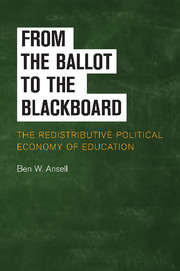Book contents
- Frontmatter
- Contents
- List of Tables
- List of Figures
- Preface
- 1 THE REDISTRIBUTIVE POLITICAL ECONOMY OF EDUCATION
- 2 THE EXPANSION OF EDUCATION TO THE MASSES: THEORY AND DATA
- 3 THE EXPANSION OF EDUCATION: HISTORICAL EVIDENCE
- 4 THE PARTISAN POLITICS OF EDUCATION
- 5 HIGH POLITICS IN HIGHER EDUCATION
- 6 CONCLUSION
- Bibliography
- Index
- Titles in the Series
5 - HIGH POLITICS IN HIGHER EDUCATION
Published online by Cambridge University Press: 06 July 2010
- Frontmatter
- Contents
- List of Tables
- List of Figures
- Preface
- 1 THE REDISTRIBUTIVE POLITICAL ECONOMY OF EDUCATION
- 2 THE EXPANSION OF EDUCATION TO THE MASSES: THEORY AND DATA
- 3 THE EXPANSION OF EDUCATION: HISTORICAL EVIDENCE
- 4 THE PARTISAN POLITICS OF EDUCATION
- 5 HIGH POLITICS IN HIGHER EDUCATION
- 6 CONCLUSION
- Bibliography
- Index
- Titles in the Series
Summary
INTRODUCTION
This chapter explores the politics of higher education spending in the OECD. In 1950, almost all OECD states had a publicly subsidized higher education system limited to a small fraction of the population. Since then, however, many states have witnessed a transformation of that elite model into a mass higher education system, with enrollment levels often exceeding 50 percent. This transition to a mass system has provoked differing funding reforms. Several states, including Australia and England, have radically altered their funding structure of higher education, moving toward the use of tuition fees. Other states, such as Sweden and Finland, have seen a huge surge in public investment in higher education accompanying mass enrollment. Finally, many states, such as Germany and Austria, retain the same elite public higher education structure with which they began the postwar era. Why did some states expand higher education while others remained in stasis? Why did some states choose to introduce tuition fees, whereas others continued to restrict investment to the public sector? Do these patterns hold at the subnational level in contexts such as the American states? In this chapter, I argue that redistributive politics plays a key role in higher education policy, but its effect is strongly conditioned by existing institutions, both political and educational – for example, the existence of a vocational education sector and the size of the existing higher education system.
- Type
- Chapter
- Information
- From the Ballot to the BlackboardThe Redistributive Political Economy of Education, pp. 164 - 222Publisher: Cambridge University PressPrint publication year: 2010

